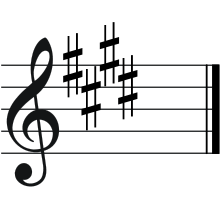C-sharp minor
 | |
| Relative key | E major |
|---|---|
| Parallel key |
C♯ major enharmonic: D♭ major |
| Dominant key | G♯ minor |
| Subdominant | F♯ minor |
| Component pitches | |
| C♯, D♯, E, F♯, G♯, A, B, C♯ | |
C-sharp minor or C♯ minor is a minor scale based on C♯, with the pitches C♯, D♯, E, F♯, G♯, A, and B. For the C-sharp harmonic minor, the B is raised to B♯. Its key signature consists of four sharps.
Its relative major is E major. Its parallel major, C♯ major, is usually replaced by D♭ major, since C♯ major, which would contain seven sharps, is not normally used. D♭ minor, having eight flats, including the B![]() , has a similar problem.
, has a similar problem.
Changes needed for the melodic and harmonic versions of the scale are written in with accidentals as necessary.
Classical music in this key
There are only two known symphonies in the 18th century written in this key. One of them is by Joseph Martin Kraus, but he appears to have found the key difficult since he later rewrote it in C minor. Even in the following two centuries, C-sharp minor symphonies remained rare. Two notable examples are the first movement of Mahler's Symphony No. 5[1]) and Prokofiev's Symphony No. 7.
This key occurs more often in piano literature from the 18th century onwards. Domenico Scarlatti wrote just two keyboard sonatas in C-sharp minor, K. 246 and K. 247. But after Beethoven's Piano Sonata No. 14 (Moonlight Sonata), the key became more frequent in the piano repertoire. Beethoven himself used this key again in the outer movements of his String Quartet No. 14 (Op. 131, 1826). Even so, Johannes Brahms still felt the need to rewrite his C-sharp minor Piano Quartet in C minor, which was published as Piano Quartet No. 3 in C minor, Op. 60.
Frédéric Chopin often wrote in this key: examples include the Fantaisie-Impromptu, Scherzo No. 3 (Op. 39), Waltz Op. 64, No. 2, and nocturnes No. 7 (Op. 27, No. 1) and No. 20 (Lento con gran espressione). Another very famous example of a work in C-sharp minor is Rachmaninoff's Prelude in C-sharp minor (Op. 3, No. 2).
Piano concertos written in C-sharp minor include Erich Wolfgang Korngold's Piano Concerto for the Left Hand, Op. 17, Nikolai Rimsky-Korsakov's Piano Concerto, and others by Ferdinand Ries, Xaver Scharwenka, Amy Beach, Miriam Hyde and Issay Dobrowen. Dmitri Shostakovich's Violin Concerto No. 2 is in C-sharp minor.
Jules Van Nuffel wrote his psalm setting In convertendo Dominus for choir and organ in C-sharp minor.
Notable songs
- Avicii – "Levels"[2]
- The Beatles – "Because"[3]
- Birdy – "Skinny Love"[4]
- Britney Spears – "Oops!... I Did It Again"[5]
- Britney Spears – "Womanizer"[6]
- The Cure – "Lullaby"[7]
- La Bouche – "Be My Lover"[8]
- Lady Gaga featuring Colby O'Donis – "Just Dance"[9]
- Linkin Park – "One Step Closer"[10]
- Kesha – "Die Young"[11]
- Led Zeppelin – "No Quarter"[12]
- Madonna – "La Isla Bonita"[13]
- Maroon 5 – "Maps"[14]
- Men at Work – "Who Can It Be Now?"[15]
- Mr. Mister – the Chorus in "Broken Wings"[16]
- Nicki Minaj – "Anaconda"[17]
- The Police – "Message in a Bottle"[18]
- Radiohead – "I Will"[19]
- Selena Gomez – "Love You like a Love Song"[20]
- Smile.dk – "Butterfly"[21]
- Train – "Drive By"[22]
- Kanye West – "Love Lockdown"[23]
References
- ↑ Constantin Floros, translated by Vernon Wicker: Gustav Mahler: The Symphonies (Portland, Oregon: Amadeus Press, 1985) p. 141 "the choice of key of the movements (C-sharp minor – A minor – D major – F major – D major);"
- ↑ "Levels" sheetmusic sample
- ↑ The Beatles "Because" sheet music sample
- ↑ "Skinny Love" sheetmusic sample – Note: The original version of the song by Bon Iver is not in C-sharp minor, but rather in A minor.
- ↑ "Oops!... I Did It Again" sheetmusic sample
- ↑ "Womanizer" sheetmusic sample
- ↑ http://www.musicnotes.com/sheetmusic/mtdFPE.asp?ppn=MN0101099&
- ↑ Amir, Saraf,. "La Bouche "Be My Lover" Sheet Music". www.musicnotes.com. Retrieved 2015-06-10.
- ↑ "Just Dance" sheetmusic sample
- ↑ http://www.musicnotes.com/sheetmusic/mtd.asp?ppn=MN0096922
- ↑ "Die Young" sheetmusic sample
- ↑ "No Quarter" sheetmusic sample
- ↑ "La Isla Bonita" sheetmusic sample
- ↑ "Maps" sheetmusic sample
- ↑ "Who Can It Be Now?" sheet music sample
- ↑ http://www.musicnotes.com/sheetmusic/mtdFPE.asp?ppn=MN0089112&
- ↑ "Anaconda" sheetmusic sample
- ↑ http://www.musicnotes.com/sheetmusic/mtdFPE.asp?ppn=MN0068333&
- ↑ Radiohead "I Will" guitar tab sample
- ↑ "Love You Like a Love Song" sheetmusic sample
- ↑ chord analysis
- ↑ "Drive By" sheet music sample
- ↑ http://www.musicnotes.com/sheetmusic/mtd.asp?ppn=MN0070083
External links
 Media related to C-sharp minor at Wikimedia Commons
Media related to C-sharp minor at Wikimedia Commons
| Diatonic scales and keys | |||||||||||||||||||||||||||||||||||||||||||||||||||||||
|---|---|---|---|---|---|---|---|---|---|---|---|---|---|---|---|---|---|---|---|---|---|---|---|---|---|---|---|---|---|---|---|---|---|---|---|---|---|---|---|---|---|---|---|---|---|---|---|---|---|---|---|---|---|---|---|
 |
| ||||||||||||||||||||||||||||||||||||||||||||||||||||||
| The table indicates the number of sharps or flats in each scale. Minor scales are written in lower case. | |||||||||||||||||||||||||||||||||||||||||||||||||||||||